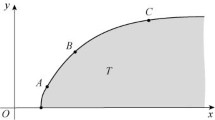Abstract
Examination of the relation between scale economies and natural monopoly has been a central issue in public policy research. The paper employs Data Envelopment Analysis (DEA) methodology to re-examine the issue of natural monopoly for the Bell system with annual time series data for 1947--1977. Results from the DEA-based statistical tests reveal the prevalence of increasing returns to scale for the Bell system, implying that there were economies of scale for the Bell system. This evidence suggests that the Bell data was indeed consistent with a natural monopoly. Further, the results indicate that the low level of overall efficiency primarily results from allocative inefficiency rather than technical and scale inefficiency.
Similar content being viewed by others
References
Banker, R.D. (1984). “Estimating Most Productive Scale Size Using Data Envelopment Analysis.” European Journal of Operations Research, 17, 35–44.
Banker, R.D. (1993). “Maximum Likelihood, Consistency and Data Envelopment Analysis: A Statistical Foundation.” Management Science, 39, 1265–1273.
Banker, R.D. and H. Chang. (1995). “A Simulation Study of Hypothesis Tests for Differences in Efficiencies.” International Journal of Production Economics, 39, 37–54.
Banker, R.D. and H. Chang. (2002). “Tests of Returns to Scale for Monotone Concave Production Function.” The University of Texas at Dallas, Working Paper.
Banker, R.D., A. Charnes, and WW. Cooper. (1984). “Models for the Estimation of Technical and Scale Inefficiencies in Data Envelopment Analysis.” Management Science, 30, 1078–1092.
Banker, R.D. and A. Maindiratta. (1988). “Nonparametric Analysis of Technical and Allocative Efficiencies in Production.” Econometrica, 56, 1315–1332.
Cave, M., S. Majumdar, and I. Vogelsang. (2002). “Structure, Regulation and Competition in the Telecommunications Industry.” In M. Cave, S. Majumdar, and I. Vogelsang (eds.), Handbook of Telecommunications Economics, Vol. 1. Amsterdam, Elsevier Science BV.
Charnes, A., W.W. Cooper, and E. Rhodes. (1981). “Program Evaluation and Managerial Efficiency: An Application of Data Envelopment Analysis to Program Follow Through.” Management Science, 27, 668–697.
Charnes, A., W.W. Cooper, and A.P. Schinnar. (1982). “Transforms and Approximation in Cost and Production Function Relations.” Omega-International Journal of Management Science, 10, 207–211.
Charnes, A., W.W. Cooper, and T. Sueyoshi. (1988). “A Goal Programming/Constrained Regression Review of The Bell System Break Up.” Management Science, 34, 1–26.
Evans, D. and J. Heckman. (1983). “Multiproduct Cost Function Estimates and Natural Monopoly Tests for The Bell System.” In D. Evans (ed.), Breaking up Bell: Essays on Industrial Organization and Regulation, New York, North-Holland.
Evans, D. and J. Heckman. (1984). “A Test for Subadditivity of the Cost Function with an Application to the Bell System.” American Economic Review September, 615–623.
Evans, D. and J. Heckman. (1988). “Natural Monopoly and the Bell System: Response to Charnes, Cooper and Sueyoshi.” Management Science, 34, 27–38.
Gold, B. (1981). “Changing Perspectives on Size, Scale and Returns: An Interpretive Survey.” Journal of Economic Literature, 19, 5–33.
Greenwald, B.C. and W.W. Sharkey. (1989). “The Economics of Deregulation of Local Exchange Telecommunications.” Bellcore Economics Discussion Paper #56.
Littlechild, S.C. (1979). Elements of Telecommunications Economics. Peter Peregrinus, Ltd, New York.
Majumdar, S. (1998). “On the Utilization of Resources: Perspectives from the U.S. Telecommunications Industry.” Strategic Management Journal, 19, 809–831.
Majumdar, S. and H. Chang. (1996). “Scale Efficiencies in U.S. Telecommunications: An Empirical Investigation.” Managerial and Decision Economics, 17, 303–318.
Majumdar, S. and H. Chang. (1998). “Optimal Local Exchange Carrier Size.” Review of Industrial Organization 13, 637–649.
Roller, L.-H. (1990). “Proper Quadratic Cost Functions with an Application to The Bell System.” Review of Economics and Statistics, 72, 202–210.
Shephard, R.W. (1970). The Theory of Cost and Production Functions. Princeton, NJ, Princeton University Press
Waverman, L. (1989). “U.S. Inter-exchange Competition.” In R. Crandall and K. Flamm (eds.), Changing the Rules: Technological Change, International Competition and Regulation in Commnications. The Brookings Institution, Washington, D.C.
Author information
Authors and Affiliations
Corresponding author
Rights and permissions
About this article
Cite this article
Chang, H., Mashruwala, R. Was the bell system a natural monopoly? An application of data envelopment analysis. Ann Oper Res 145, 251–263 (2006). https://doi.org/10.1007/s10479-006-0033-8
Published:
Issue Date:
DOI: https://doi.org/10.1007/s10479-006-0033-8




